SRI KRISHNA ELEN DWARAKAY
(Sri Krishna comes to Dwarakay)
|
|
BISHANNA SRI KRISHNA
(Sree Krishna cast down)
|
 Sri Krishna emancipated his birthplace Mathura from the
clutches of tyranny of Kansha and forsook his friends and relations to
build his new kingdom in Dwaraka. This novel is a clear picture of the
struggles and sufferings, tolerance and resistance of the oppressed to keep
their loving Krishna safe, social and cunning ways of selfdefence of
Krishna.
Sri Krishna emancipated his birthplace Mathura from the
clutches of tyranny of Kansha and forsook his friends and relations to
build his new kingdom in Dwaraka. This novel is a clear picture of the
struggles and sufferings, tolerance and resistance of the oppressed to keep
their loving Krishna safe, social and cunning ways of selfdefence of
Krishna.
|
|
 After the battle of Kurukshetra , Sri Krishna was mentally tormented by the question as to what he was able
to give to man. He held himself blameworthy. He was the puppet in the Hands
of destiny. His power was too little to bring the quarrelling hostile
yadavas back to peaceful, harmonious life. None of the Yadavas listened to
him. The novel is written on the back-ground of Sri Krishna's failures and
frustrations.
After the battle of Kurukshetra , Sri Krishna was mentally tormented by the question as to what he was able
to give to man. He held himself blameworthy. He was the puppet in the Hands
of destiny. His power was too little to bring the quarrelling hostile
yadavas back to peaceful, harmonious life. None of the Yadavas listened to
him. The novel is written on the back-ground of Sri Krishna's failures and
frustrations.
|
|
|
|
SRIKRISHHA SUNDARAM
(Sri.Krishna, beauty epitomized)
|
|
YADI RADHA NA HOTO
(If there were no Radha)
|
 The present novel relates the sweetness of all the lovable
activities of Sri Krishna. In the joyless land the sweet notes of Sri
Krishna flute convey the spirit of freedfm. Like the love-mad Radha, they
are out to welcome the great life of freedom. throwing off all the fears and hesitations.
The present novel relates the sweetness of all the lovable
activities of Sri Krishna. In the joyless land the sweet notes of Sri
Krishna flute convey the spirit of freedfm. Like the love-mad Radha, they
are out to welcome the great life of freedom. throwing off all the fears and hesitations.
|
|
 The everlasting love-story of Radha and Krishna has become
the modern literary wealth in a different form and ground. Radha is the symbol
of irresistible passion. The love-bound figures of Krishna and Radha
symbolize the unquenchable passion and the sweetness of union. Krishna has
nothing without Radha. Where would the amative, romantic Krishna be without Radha.
The everlasting love-story of Radha and Krishna has become
the modern literary wealth in a different form and ground. Radha is the symbol
of irresistible passion. The love-bound figures of Krishna and Radha
symbolize the unquenchable passion and the sweetness of union. Krishna has
nothing without Radha. Where would the amative, romantic Krishna be without Radha.
|
|
|
|
KRISHNASTU BHAGAWAN
(Krishna, Lord himself)
|
|
KRISHNA ARJUN SANBAD
(Dialogue between Krishna and Arjuna)
|
 Krishna, born of a human mother, revealed himself in many
activities in such a way that he became the center of all the people's
curiosities and questions. How Krishna became the enormously powerful
personality, which brought him the status of divinity, has become the
enjoyable ingredient of this novel.
Krishna, born of a human mother, revealed himself in many
activities in such a way that he became the center of all the people's
curiosities and questions. How Krishna became the enormously powerful
personality, which brought him the status of divinity, has become the
enjoyable ingredient of this novel.
|
|
 The spirited, inspiring persuasive speech of Krishna
delivered on the eve of the great battle at Kurukshetra was the divine
messaage of the Geeta. Arjun became too disappointed and sorrowful to
fight. He was reminiscing about the past causes of the battle, and becoming
impatient and restless with an irresistible desire to protest. Krishna came
up to remove all the hesitations, distracting ideas one by one gradually
and take to a point of deterimination and confidence. This novel relates
the complex background in the form of enjoyable novel.
The spirited, inspiring persuasive speech of Krishna
delivered on the eve of the great battle at Kurukshetra was the divine
messaage of the Geeta. Arjun became too disappointed and sorrowful to
fight. He was reminiscing about the past causes of the battle, and becoming
impatient and restless with an irresistible desire to protest. Krishna came
up to remove all the hesitations, distracting ideas one by one gradually
and take to a point of deterimination and confidence. This novel relates
the complex background in the form of enjoyable novel.
|
|
|
|
MON VRINDABON
(Sweeter relation of love)
|
|
JAGADDHITAYA SRI KRESHNA
(Life of Sri Krishna) - Edited.
|
 The relation of love between Krishna and the Gopinies became
sweet and then sweeter.The life which originated in Brajabhumi could not be
felt for the po-litical turmoils. Krishna became eager for Brajabhumi when
life become joyless, dis-appointing and the pride of authority and power
died out. Shaving off all these, Krishna’s mind turned into Vrindaban.
The relation of love between Krishna and the Gopinies became
sweet and then sweeter.The life which originated in Brajabhumi could not be
felt for the po-litical turmoils. Krishna became eager for Brajabhumi when
life become joyless, dis-appointing and the pride of authority and power
died out. Shaving off all these, Krishna’s mind turned into Vrindaban.
|
|
Sri Krishna was not only a
complete man but also a complete incarnation of the Super being. On the
basis of the epic and the myth of ancient India, the pen of Sri Durgadas
Lahiri has opened out a new vista of historical and philosophical re
searches into the characters of Krishna as a fighter and as a lover. It's a
new ad- dition to the Krishna Charitra by Bankim Chandra Chattopadhyay.
|
|
|
|
DROUPAPI CHIRANIANI
(Draupadi, the eternal)
|
|
TOMARI NAM KARNA
(Your name is Kama)
|
 Droupadi not only stood out as the central character at the
stage of preparation for the great Indian war but also reflected the lives
of Indian women in the colourful background The writer has sought to bring
out the inner self of this woman, a self-sacrificing character victimized
by political interests. In the light of psychological truth the writer has
tried to reveal the mind of this woman who has ventured to protest like a
modern woman of strong personality.
Droupadi not only stood out as the central character at the
stage of preparation for the great Indian war but also reflected the lives
of Indian women in the colourful background The writer has sought to bring
out the inner self of this woman, a self-sacrificing character victimized
by political interests. In the light of psychological truth the writer has
tried to reveal the mind of this woman who has ventured to protest like a
modern woman of strong personality.
|
|
 Karna was the unfortunate, struggling man of this familiar
society. He always struggled to establish his own demand as a man with all
his rights. He was tormented by the painful struggles with his friends and
others of blood relation and against his mysterious birth.
Karna was the unfortunate, struggling man of this familiar
society. He always struggled to establish his own demand as a man with all
his rights. He was tormented by the painful struggles with his friends and
others of blood relation and against his mysterious birth.
|
|
|
|
MAHABHARATE SAKUNI
(Shakuni, in the Mahabharat)
|
|
PITAMAHA BHISHMA
(Grand father Bhishma)
|
 Was Sakuni really a villain? The nobleness of his real self
suppressed by slanders and falsehoods is really startling. His selfless
love and affection for her sister and attachment to his sister's son. his patriotism, greedlessness have given him a new
identity. A new Shakuni is brought to light by the new evaluation of
humanity.
Was Sakuni really a villain? The nobleness of his real self
suppressed by slanders and falsehoods is really startling. His selfless
love and affection for her sister and attachment to his sister's son. his patriotism, greedlessness have given him a new
identity. A new Shakuni is brought to light by the new evaluation of
humanity.
|
|
 Pitamaha Bhishma was the witness of many incidents. In his
life his iron deter-mination and some of his erroneous decisions let in
Satyabati, Amba, Dwaipayan and Kunti like the irresistible destiny. The
error he committed by calling in Dwaipayan for the successor of the Kourav
dynasty was a little increased by his rejection of Amba. To divide the Kuru
kingdom into two to please the Pandavas was one of his mistakes. He atoned
for his own mistakes throughout his life.
Pitamaha Bhishma was the witness of many incidents. In his
life his iron deter-mination and some of his erroneous decisions let in
Satyabati, Amba, Dwaipayan and Kunti like the irresistible destiny. The
error he committed by calling in Dwaipayan for the successor of the Kourav
dynasty was a little increased by his rejection of Amba. To divide the Kuru
kingdom into two to please the Pandavas was one of his mistakes. He atoned
for his own mistakes throughout his life.
|
|
|
|
GANDHARI. KURKSHETRE GANDHARI
(Gandhari in Kurukshetra)
|
|
DWAIPAYANE DURYODHANA
(Duryodhana in Dwaipayan)
|
 Gandhari was the only woman who had no affection for her
children. In the midst of the dead bodies of the Kurukshetra Gandhari felt
for the first time in her life that some men presumed upon her god-fearing
simplicity and deceived her. The intermediary act of Sri. Krishna was a
cunning trick. This novel brings out the beravement and piousness of a
mother with her repentance and lamentation.
Gandhari was the only woman who had no affection for her
children. In the midst of the dead bodies of the Kurukshetra Gandhari felt
for the first time in her life that some men presumed upon her god-fearing
simplicity and deceived her. The intermediary act of Sri. Krishna was a
cunning trick. This novel brings out the beravement and piousness of a
mother with her repentance and lamentation.
|
|
 Durjodhan was defeated for his wrong strategy. After
escaping he wanted to have a new life with confidence. But he was the brave
puppet in the hands of Fate. So he was to wage war; but he was not entitled
to victory. The whimsical destiny of man took him out of the Dwaipayan Lake
to put him to death ruthlessly. But his life in paradise was not prevented.
Durjodhan was defeated for his wrong strategy. After
escaping he wanted to have a new life with confidence. But he was the brave
puppet in the hands of Fate. So he was to wage war; but he was not entitled
to victory. The whimsical destiny of man took him out of the Dwaipayan Lake
to put him to death ruthlessly. But his life in paradise was not prevented.
|
|
|
|
KURUKSHETRE DWAIPAYAN
(Dwaipayan in Kurukshetra)
|
|
SAMARAJNI KUNTI
(Empress Kunti)
|
 Maharshi Dwaipayan was not only the composer of the
Mahabharat but also one of the controlling characters. At the turns of
incidents he appeared. As he was the son of Satyabati; he had easy access
to the Hastinapur dynasty and-politics. He was not without bias; he was in
favour of the Pandavas. He became hostile to the Kouravas in his desire to
take revenge for the rejection of Amba. He was converted into a rogue from
a hermit. He pulled the string of everything . Even Krishna was a puppet in his hands.
Maharshi Dwaipayan was not only the composer of the
Mahabharat but also one of the controlling characters. At the turns of
incidents he appeared. As he was the son of Satyabati; he had easy access
to the Hastinapur dynasty and-politics. He was not without bias; he was in
favour of the Pandavas. He became hostile to the Kouravas in his desire to
take revenge for the rejection of Amba. He was converted into a rogue from
a hermit. He pulled the string of everything . Even Krishna was a puppet in his hands.
|
|
 From the day when Pritha was known as kunti, a course of
self-mortification and self-denial began In her life there were varied
processions of innumerable men and different incidents. She had the
indomitable longing to be the king's mother; she had the terrible desire to
have power. politicl dignity and honour. To fulfil
her ambition and longing for power she did not hesitate to do anything. But
her heart was lacerated with repentance when she had to pay the price for
indomitable ambition and longing.
From the day when Pritha was known as kunti, a course of
self-mortification and self-denial began In her life there were varied
processions of innumerable men and different incidents. She had the
indomitable longing to be the king's mother; she had the terrible desire to
have power. politicl dignity and honour. To fulfil
her ambition and longing for power she did not hesitate to do anything. But
her heart was lacerated with repentance when she had to pay the price for
indomitable ambition and longing.
|
|
|
|
URVASI JANANI
(Celestial woman, Urvasi the mother)
|
|
EBONG ASVATHAMA
(At last Asvathama)
|
 Urvasi, the cause of strong passion in men had the universal
mother in her. She sacrifiee the traditional chastity and honour of a woman
in the interest of her husband Pururaba's political gains and then got lost
in the world of darkness where from no woman ever came back. When Arjuna
called her 'a mother ', she seemed to wake up from the self-forgetfulness
and it was then that the dignified whore became a real mother.
Urvasi, the cause of strong passion in men had the universal
mother in her. She sacrifiee the traditional chastity and honour of a woman
in the interest of her husband Pururaba's political gains and then got lost
in the world of darkness where from no woman ever came back. When Arjuna
called her 'a mother ', she seemed to wake up from the self-forgetfulness
and it was then that the dignified whore became a real mother.
|
|
 The battle of Kurukshetra was not ended with the fall of Durjodhan. Aswathama who was extremely hostile to Panchal,
was made the chief of soldiers with. a view to
reviving the battle and the hostility. Consequentlythe fight crossing the
limits of hostility between brothers, sneaked into the long lasting domain
of division and enmity between Panchal and Hastinapur.
The battle of Kurukshetra was not ended with the fall of Durjodhan. Aswathama who was extremely hostile to Panchal,
was made the chief of soldiers with. a view to
reviving the battle and the hostility. Consequentlythe fight crossing the
limits of hostility between brothers, sneaked into the long lasting domain
of division and enmity between Panchal and Hastinapur.
|
|
|
|
ASHRAM KANYA SAKUNTALA
|
|
SAPTA SINDHUR PUTRA
KANYA
|
 Shakuntala struggled within herself every moment to get rid
of the adversities of rejection of her love and to be brave enough to
remain truthful to her conscience. Despite the rejection by her M lover,
she showed the boldness to bring her desired child to this world and toy. bring him up without anybody's help. Her mental power
has placed her in the same g rank as the modern women who believe in
women's liberation.
Shakuntala struggled within herself every moment to get rid
of the adversities of rejection of her love and to be brave enough to
remain truthful to her conscience. Despite the rejection by her M lover,
she showed the boldness to bring her desired child to this world and toy. bring him up without anybody's help. Her mental power
has placed her in the same g rank as the modern women who believe in
women's liberation.
|
|
 History is the main matter in the hostilities and struggles
between the Aryans and the non-Aryans, the Gods and the demons on the
background of Indus civilization. All the stories speak volumes of the
gradual progress of human civilization spread over a period of twenty
thousand years and extending upto the Indus civilization.
History is the main matter in the hostilities and struggles
between the Aryans and the non-Aryans, the Gods and the demons on the
background of Indus civilization. All the stories speak volumes of the
gradual progress of human civilization spread over a period of twenty
thousand years and extending upto the Indus civilization.
|
|
|
|
MAHAVISHWE MADHU KAITAV
(Madhu and Kaitav, two demons in cosmos)
A MYTHOLOGY- BASED SCIENCE-FICTION FOR THE YOUNG
|
|
LANKESH RAVANA
(Havana, the king of Lanka)
|
 There are the startling facts of science in the story of
Madhu KAITAV. Mythology is the symbolised facts of science regarding the
intricate states of creation of science and the mystery of evolution
through various stages. All the stories traversing the universe with the
startling scientific facts are impressive and pleasant-reading.
There are the startling facts of science in the story of
Madhu KAITAV. Mythology is the symbolised facts of science regarding the
intricate states of creation of science and the mystery of evolution
through various stages. All the stories traversing the universe with the
startling scientific facts are impressive and pleasant-reading.
|
|
 The Ravan was established in politics by hard struggles. He
became the leader of a weak, undeveloped race and engaged s in fighting
against a strong, imperial and aggressive power to gain his own control.
His key to success was his towering confidence and love of his country and
countrymen. He gained his command over India on the basis of his own
successful efforts.
The Ravan was established in politics by hard struggles. He
became the leader of a weak, undeveloped race and engaged s in fighting
against a strong, imperial and aggressive power to gain his own control.
His key to success was his towering confidence and love of his country and
countrymen. He gained his command over India on the basis of his own
successful efforts.
|
|
|
|
RAMER AGNATABAS
(Rama's exile)
|
|
RAJA RAM
(Rama the king)
|
 Ramchandra left his relations, throne and family and plotted
to kill Ravana in association with the hermits to establish his colony and
Aryan empire this book throws light on how Ram's life in the jungles
be-came the cause of making Ravana friend-less and powerless.
Ramchandra left his relations, throne and family and plotted
to kill Ravana in association with the hermits to establish his colony and
Aryan empire this book throws light on how Ram's life in the jungles
be-came the cause of making Ravana friend-less and powerless.
|
|
 Ater the battle of Lanka, Ramchandra entered his empire
ferociously with his army, but his being the king of the country, brought
his country social restlessness disorder and various other troubles. Rambanished
Sita from the country when he unable to remove economic misery and
displeasure of his countrymen. Even Lakshana drowned himself in the river
Saruiu and died.
Ater the battle of Lanka, Ramchandra entered his empire
ferociously with his army, but his being the king of the country, brought
his country social restlessness disorder and various other troubles. Rambanished
Sita from the country when he unable to remove economic misery and
displeasure of his countrymen. Even Lakshana drowned himself in the river
Saruiu and died.
|
|
|
|
JANANI KAIKEYI
(Kaikeyi, the mother)
|
|
AMITOMADERI SITA
(I am your Sita)
|
 The clean motherhood of Kaikeyi was stingmatised to hide the
crisis regarding the succession to throne. She had to undergo suspicion,
censure and stigma as she could not cross the limit of an ordinary mother.
But Dasarath was to blame for all this. A long story of establishing the
glory of her motherhood has been related here.
The clean motherhood of Kaikeyi was stingmatised to hide the
crisis regarding the succession to throne. She had to undergo suspicion,
censure and stigma as she could not cross the limit of an ordinary mother.
But Dasarath was to blame for all this. A long story of establishing the
glory of her motherhood has been related here.
|
|
 Ram was rendered impatient and displeased by Sita's
politeness, modest protest and direct opposition. So, to divert the public
attention from total disorder and lack of peace in the country Ram sent
parturient Sita to the jungle full of ferocious animals for her death. In
the suppression of the father's identity of Laba and Kusha the sense of
self-respect of the women of this age can be seen.
Ram was rendered impatient and displeased by Sita's
politeness, modest protest and direct opposition. So, to divert the public
attention from total disorder and lack of peace in the country Ram sent
parturient Sita to the jungle full of ferocious animals for her death. In
the suppression of the father's identity of Laba and Kusha the sense of
self-respect of the women of this age can be seen.
|
|
|
|
BIBHISHANA
(Bibhishan, the brother of Ravana)
|
|
ACHENA BHARAT
(The unknown Bharat)
|
 Bibhisan was made treacherous by his irrepressible longing
to get his brother's wife as his own and by his greed for throne. What did
he get by his passionate desire which caused bloodshed, death and
destruction of Lanka? Where did he arrive by his elusive love and
frustration? Did he get the gratification of his desire?
Bibhisan was made treacherous by his irrepressible longing
to get his brother's wife as his own and by his greed for throne. What did
he get by his passionate desire which caused bloodshed, death and
destruction of Lanka? Where did he arrive by his elusive love and
frustration? Did he get the gratification of his desire?
|
|
 Bharat had no role in the struggle between royal power and
Branaman's authority over the succession to the throne of Ayodha, but he
got all the blame. A temporary settlement was made by the departure of Ram
and the presence of Bharat for the succession. But, as Bharat would not be
able to give up royal power, Ram entered the kingdom with bis army. Understanding his own danger, Bharat gave way
to Ram easily and openly.
Bharat had no role in the struggle between royal power and
Branaman's authority over the succession to the throne of Ayodha, but he
got all the blame. A temporary settlement was made by the departure of Ram
and the presence of Bharat for the succession. But, as Bharat would not be
able to give up royal power, Ram entered the kingdom with bis army. Understanding his own danger, Bharat gave way
to Ram easily and openly.
|
|
|
|
UPEKSfHTA SURPANAKHA
(The neglected Shurpanakha)
|
|
SUDHA SAGAR TEERAE
(Various essays on the mythological topics)
|
 She was a neglected woman in the Ramayan. When her life was
shattered for the killing of her husband by Ravan, she was infuriated with
her desire for revenge which resulted in abduction of Sita, battle and
death. She too was not spared from shedding tears. This novel is the clear
picture of her love, lamentation, revenge and treachery.
She was a neglected woman in the Ramayan. When her life was
shattered for the killing of her husband by Ravan, she was infuriated with
her desire for revenge which resulted in abduction of Sita, battle and
death. She too was not spared from shedding tears. This novel is the clear
picture of her love, lamentation, revenge and treachery.
INDRAPRASTHE SRIKRISHNA
(Sri Krishna at Indraprastha)
 Hastinapur and Indraprastha these two places alternate as
the hubs of Kuru-Pandava squabbles and political turmoil. And the political
maelstrom has always dragged in Sri Krishna directly or indirectly. The
curtain rises at the swoyamvara of Draupadi. Then the entire chain of the
Mahabharata events revoives round Krishna's diplomacy and political
manoeuvererings. His dreams, political ambition and pride of authority
permeate this novel to give it absorbing readability.
Hastinapur and Indraprastha these two places alternate as
the hubs of Kuru-Pandava squabbles and political turmoil. And the political
maelstrom has always dragged in Sri Krishna directly or indirectly. The
curtain rises at the swoyamvara of Draupadi. Then the entire chain of the
Mahabharata events revoives round Krishna's diplomacy and political
manoeuvererings. His dreams, political ambition and pride of authority
permeate this novel to give it absorbing readability.
|
|
 It contains various essays on the mythological topics the
true purports of which are reflected in the minds of readers in new forms.
All the essays are rich with novel and modern thoughts and ideas. The
ancient days have become one with the present ones. The same tradition of
India is going on still now. The same attitudes have not been changed even
after five thousand years.
It contains various essays on the mythological topics the
true purports of which are reflected in the minds of readers in new forms.
All the essays are rich with novel and modern thoughts and ideas. The
ancient days have become one with the present ones. The same tradition of
India is going on still now. The same attitudes have not been changed even
after five thousand years.
KAKATALIYA, AMRITA KUMBHA, KUNTIR TARJANI, YOJANGANDHA SATYABATI,
ASWAMEDEHER BAJI, POURANIK PREMKATHA, PUNNYER ALO, RUPANTAR
All these are the compilations of short stories written on
the vedic, upanishadic, Budhistic and Ramayan Mahabharata, anecdotes. These
are the stories in the modern setting reflecting the insults and mental
pangs of man suffered through ages by the rigours of social and ethical
rules and regulations, and man's grievances and efforts to get rid of those
rigours.
|
|
|
|
BANGLA NATAKE ADUNIKATA O
GANACHETANA
|
|
NIVEDITO MARGARET
|
 The freedom of Bengali drama has been effected through mass consciousness. The characte of dramas have been changed
because of maldistribution of wealth, exploitation and deprivation and the
magnetic attraction of socialism. It presents the facts of lives and
analysis of literary works of those who welcomed the new age of drama. It
is the only helpful book in knowing the course of modern drama after the
two world wars.
The freedom of Bengali drama has been effected through mass consciousness. The characte of dramas have been changed
because of maldistribution of wealth, exploitation and deprivation and the
magnetic attraction of socialism. It presents the facts of lives and
analysis of literary works of those who welcomed the new age of drama. It
is the only helpful book in knowing the course of modern drama after the
two world wars.
|
|
 The life of the Irish Girl Margaret Eliza-beth was the
previous life of Sister Nivedita. This book contains the unknown,
struggling personality of a woman who was sacrificed to God before birth
and how far her life was devoted to the service of the miserable.
The life of the Irish Girl Margaret Eliza-beth was the
previous life of Sister Nivedita. This book contains the unknown,
struggling personality of a woman who was sacrificed to God before birth
and how far her life was devoted to the service of the miserable.
|
|
|
|
NIVEDITO NIVEDITA
|
|
BHARAT TIRTHE NIVEDITA
|
 The deep love of Vivekananda was at th root of her being
Sister Nivedita. Attracted by his deep love she came to Calcutta. The story
that had its origin in England was extended to Calcutta. A unique life of
pleasure of having everything inspite of forsaking all was not built in a
day. Bagbazar and Belur were the witnesses of all the changes in her life
in association with Vivekananda. But above all, her devotion to and love
for Vivekananda became the greatest.
The deep love of Vivekananda was at th root of her being
Sister Nivedita. Attracted by his deep love she came to Calcutta. The story
that had its origin in England was extended to Calcutta. A unique life of
pleasure of having everything inspite of forsaking all was not built in a
day. Bagbazar and Belur were the witnesses of all the changes in her life
in association with Vivekananda. But above all, her devotion to and love
for Vivekananda became the greatest.
|
|
 Vivekananda made Nivedita his companion in his travelling in
the Himalayas as in her mind there was an undercurrent of love and devotion.
In the Himalayas at every moment she filled herself up with all the
thoughts and ideas of Vivekananda. During the days of her traveling in the
Himalayas her mental changes and outlook of life achieved. Such excellence
that brought about a new change in her life afterwards.
Vivekananda made Nivedita his companion in his travelling in
the Himalayas as in her mind there was an undercurrent of love and devotion.
In the Himalayas at every moment she filled herself up with all the
thoughts and ideas of Vivekananda. During the days of her traveling in the
Himalayas her mental changes and outlook of life achieved. Such excellence
that brought about a new change in her life afterwards.
|
|
|
|
BIDROHINI NIVEDITA
(Revolting spirit of Nivedita)
|
|
ADAM-EVE
|
 Nivedita's blood contained politics and re-volting spirit.
Being unable to tame the in-domitable spirit in herself . Swamji set her free. But she cherished deep love of and respect to Swamiji.
She drifted herself with the current of Swadeshi movement to embody the
incomplete patriotic ideas of her Guide Swamiji. The unfurled sail of
Vivekananda received the current of revolt of Nivedita.
Nivedita's blood contained politics and re-volting spirit.
Being unable to tame the in-domitable spirit in herself . Swamji set her free. But she cherished deep love of and respect to Swamiji.
She drifted herself with the current of Swadeshi movement to embody the
incomplete patriotic ideas of her Guide Swamiji. The unfurled sail of
Vivekananda received the current of revolt of Nivedita.
|
|
 There are a lot of question regarding the relation between
man and woman moving in the vortex of problems. A writer aged over sixty
years and a female reader aged over thirty years - these two persons are at
the two points of marriage after love and marriage without being involved
in marriage. One of them is married and another unmarried. The voluntary
sacrifice of the body arouses a number of questions in the minds of man. and woman and on this background this book has been
written. A triangular love-affair has been created by the writer himself,
his wife and his female reader.
There are a lot of question regarding the relation between
man and woman moving in the vortex of problems. A writer aged over sixty
years and a female reader aged over thirty years - these two persons are at
the two points of marriage after love and marriage without being involved
in marriage. One of them is married and another unmarried. The voluntary
sacrifice of the body arouses a number of questions in the minds of man. and woman and on this background this book has been
written. A triangular love-affair has been created by the writer himself,
his wife and his female reader.
|
|
|
|
POURANIKI PREMKATHA
|
|
SWARNA MARICHIKA
(Golden Mirage)
|
Pouraniki Premkatha is a huge domain of love affairs of men
and women which brings to light the variety, extent and largeness or lowliness
flowing in different channels of life and death, problems of life,
conflicts and hostilities go beyond the extent of time or age in all the
stories mythicised- Pouranik Premkatha is the standard bearer of familiar
love stories of well-known life wherein all the people are but men and
women still now despite external changes.
|
|
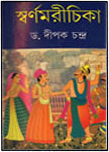 Five novels of Swarna Marichika - Lankes Ravan. Swama
Marichika, Bibhisan, Surpanakha and Kumbhakama turn into comprehensive
history of Lanka Dynasty and Aryan Colonisation as these five in the hot
political atmosphere of patriotism and imperial greed, freedom of country
and sovereignty, reveal the stories of imperialism and hard struggle,
sacrifice and revenge, greed, selfishness and malice of the Ramayana in the
light of life-study.
Five novels of Swarna Marichika - Lankes Ravan. Swama
Marichika, Bibhisan, Surpanakha and Kumbhakama turn into comprehensive
history of Lanka Dynasty and Aryan Colonisation as these five in the hot
political atmosphere of patriotism and imperial greed, freedom of country
and sovereignty, reveal the stories of imperialism and hard struggle,
sacrifice and revenge, greed, selfishness and malice of the Ramayana in the
light of life-study.
|
|
|
|
PANCHA MATRIKA
(Five Mothers)
|
|
KALCHAKRA
(The Wheel of Time)
|
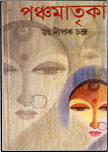 It's the life-history of five equal-minded women of the
epics. There is little difference between the crises and problems of their
live in the age with those of modern times. These five women, unfortunate,
oppressed, deprived and neglected by their husbands, set themselves up in
the frm position of honour by defeating adversities, sacrifices and
self-denials and the sole right to motherhood. The other sacred mothers shining
with attractive sweetness, liberalism and elegance of nature are Sakuntala.
Sita, Uravashi. Gandhari and Radha.
It's the life-history of five equal-minded women of the
epics. There is little difference between the crises and problems of their
live in the age with those of modern times. These five women, unfortunate,
oppressed, deprived and neglected by their husbands, set themselves up in
the frm position of honour by defeating adversities, sacrifices and
self-denials and the sole right to motherhood. The other sacred mothers shining
with attractive sweetness, liberalism and elegance of nature are Sakuntala.
Sita, Uravashi. Gandhari and Radha.
|
|
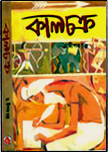 The wheel of time indicted on the circle of Mahabharata has
gone ahead in the three ways. Kashyapeya represents the history of
world-traversing of mankind from the Harappa to Vedic India. 'Kurukshetra
Dwaipayan" depicts the ultimate end of the strife between the Kauravas
and the Pandavas and the changes taking place thereafter. The destruction
of the hard earned civilization of man in the subversive vortex of politics
and its consequences are the crux of the wheel of time.
The wheel of time indicted on the circle of Mahabharata has
gone ahead in the three ways. Kashyapeya represents the history of
world-traversing of mankind from the Harappa to Vedic India. 'Kurukshetra
Dwaipayan" depicts the ultimate end of the strife between the Kauravas
and the Pandavas and the changes taking place thereafter. The destruction
of the hard earned civilization of man in the subversive vortex of politics
and its consequences are the crux of the wheel of time.
|
|
|
|
Panchti Rani Kahini
(Five Queens)
|
|
Shri Krishna Purushottam
(Shri Krishna the Greatest men)
|
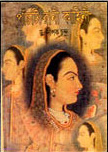 Five queens of the Ramayan and Mahabharat avenged themselves
for the insult, deprivation and oppression suffered by them because of the
smoldering jealousy, malice, hatred and desire for revenge. The tire
ignited for their falling preys to the politics and dark desire for
imperialism, for their sacred womanhood being trampled burnt homes,
families and lineage. Though kingdoms were destroyed for them there was no
compunction in their hearts. The women responsible and responsible for the
two internecine wars of the two epics arc Kaikeyee, Surpanakha, Satyabati,
Kunti and Draupadi.
Five queens of the Ramayan and Mahabharat avenged themselves
for the insult, deprivation and oppression suffered by them because of the
smoldering jealousy, malice, hatred and desire for revenge. The tire
ignited for their falling preys to the politics and dark desire for
imperialism, for their sacred womanhood being trampled burnt homes,
families and lineage. Though kingdoms were destroyed for them there was no
compunction in their hearts. The women responsible and responsible for the
two internecine wars of the two epics arc Kaikeyee, Surpanakha, Satyabati,
Kunti and Draupadi.
|
|
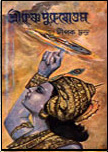 Krishna the only life spirit of the Mahabharata, made the
whole of India his field of activities. He was the lovable king of all
hearts, great fighter, politician, diplomat, establisher of peace and true
religion. The triology Srikrishna Purushottam comprising Indraprastha
Srikrishna, Shri Krishna Elen Dwarakay and Vishanna Sri Krishna is
essential to know and feel the greatness of political life and activity of
Sri Krishna.
Krishna the only life spirit of the Mahabharata, made the
whole of India his field of activities. He was the lovable king of all
hearts, great fighter, politician, diplomat, establisher of peace and true
religion. The triology Srikrishna Purushottam comprising Indraprastha
Srikrishna, Shri Krishna Elen Dwarakay and Vishanna Sri Krishna is
essential to know and feel the greatness of political life and activity of
Sri Krishna.
|
|
|
|
Pandavder Mahaprasthaner Pathe
|
|
Agnigarbha Khandav
|
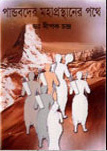 We are not separate or diverse despite our differences in
language and dress. Where will such a panorama of harmony and solidarity be found except in the Himalaya? Such a panorama has
been observed from Hardwar to Kedarnath and Baidyanath via Hrishikesh. This
was consecrated by the footsteps of Ram,
Laxman Bharat,and Satrughna. Following the beaten track of theirs, the
Pandavas went along to Heaven. The presentation is purported to relieve the
weariness of plodding along this path.
We are not separate or diverse despite our differences in
language and dress. Where will such a panorama of harmony and solidarity be found except in the Himalaya? Such a panorama has
been observed from Hardwar to Kedarnath and Baidyanath via Hrishikesh. This
was consecrated by the footsteps of Ram,
Laxman Bharat,and Satrughna. Following the beaten track of theirs, the
Pandavas went along to Heaven. The presentation is purported to relieve the
weariness of plodding along this path.
|
|
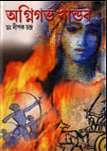 The Conflagration( dabanal) of
Khandav- ban is the incident of mass-rebellion. Fire and burnig of forest
symbolise insurgency. The narrative presents the probable rebellion and
vengeance ensuing from exploitation, oppression and deprivation of the
down-trodden in society and their rage. Needless to say separatism
griginating from brings about terrorism. The murder of Parikshit represents
the activity of the trained suicide squad of terrorists. The sarpasatra
Jagna of Janomenjoy is the vast preparationto eradicate terrorism.
The Conflagration( dabanal) of
Khandav- ban is the incident of mass-rebellion. Fire and burnig of forest
symbolise insurgency. The narrative presents the probable rebellion and
vengeance ensuing from exploitation, oppression and deprivation of the
down-trodden in society and their rage. Needless to say separatism
griginating from brings about terrorism. The murder of Parikshit represents
the activity of the trained suicide squad of terrorists. The sarpasatra
Jagna of Janomenjoy is the vast preparationto eradicate terrorism.
|
|
|
|
Galpe Galpe Ganga
|
|
Mahabharater Pasa
|
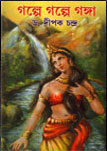 Ganga is not dependent on rain. To maintain the navigability
of the Ganga the monarchs of the Ikhhaku dynasty visited the Himalayas
again and again. The silt of the Himalayan earth brought by the melting of the
ice obstruct the course of the Ganga. There are
stories containted in the story of bringing Ganga on the earth by
Bhagirath.The course of Ganga towards the
seas was not very smooth. Bhagirath removed thgose obstacles and showed the
way bringing Ganga on Makar, which means the navigability was created by
cutting the earth with dredger.
Ganga is not dependent on rain. To maintain the navigability
of the Ganga the monarchs of the Ikhhaku dynasty visited the Himalayas
again and again. The silt of the Himalayan earth brought by the melting of the
ice obstruct the course of the Ganga. There are
stories containted in the story of bringing Ganga on the earth by
Bhagirath.The course of Ganga towards the
seas was not very smooth. Bhagirath removed thgose obstacles and showed the
way bringing Ganga on Makar, which means the navigability was created by
cutting the earth with dredger.
|
|
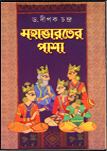 Sin found it way through the play of pasa who was
responsible for it? Durjodhan or Judhisthir? Yudhisthir wanted to be
defeated because of political reason. The Pasha-playing episodes were
constructed very skilfully by the artistic skill and verbosity. It was a
very cunningly planned political intrigue, This
book contains such a description.
Sin found it way through the play of pasa who was
responsible for it? Durjodhan or Judhisthir? Yudhisthir wanted to be
defeated because of political reason. The Pasha-playing episodes were
constructed very skilfully by the artistic skill and verbosity. It was a
very cunningly planned political intrigue, This
book contains such a description.
|
|
|
|
Nirab Praner Devata
|
|
Kumbhakarner Prtyabartan
|
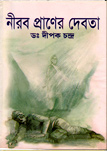 The country India described in the Vedas. Upanishads and
mythology was derived from the HIMALAYAS. So, the pilgrimage to Amarnath
symbolise the visit to the whole of India. T Hindu tradition from time to
time visit from time to time immemorial is
felt while journeying from KASHMIR TO Amarnath . Man becomes the living
Amarnath. The close association is reflected in the mirror of human mind. Then heaven reigns among human
society.
The country India described in the Vedas. Upanishads and
mythology was derived from the HIMALAYAS. So, the pilgrimage to Amarnath
symbolise the visit to the whole of India. T Hindu tradition from time to
time visit from time to time immemorial is
felt while journeying from KASHMIR TO Amarnath . Man becomes the living
Amarnath. The close association is reflected in the mirror of human mind. Then heaven reigns among human
society.
|
|
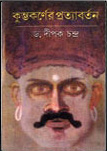 Kumbhakarna is not a demon. Rather,he was a scientist .The device resembling a human is named Kumbhakarna.
The robotic warfare was introduced by the rakshas into the Ramayana. The
Kumbhakarna that warred with Ram was a robot
that was confused with the actual Kumbhakarna. This is a unique narration
of the recovery of the human entity of Kumbhakarna.
Kumbhakarna is not a demon. Rather,he was a scientist .The device resembling a human is named Kumbhakarna.
The robotic warfare was introduced by the rakshas into the Ramayana. The
Kumbhakarna that warred with Ram was a robot
that was confused with the actual Kumbhakarna. This is a unique narration
of the recovery of the human entity of Kumbhakarna.
|
|
|
|
Chakrabuha
|
|
Upanishade Tin Ramani
|
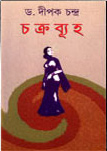 Chakrabuha is a narrative of a struggling girl who is
impriosoned in the circle(buha) of life from which
there is no way out for her. Her life is a devious course through the rough ways of intricacies, intrigues and prejudices of
life.
Chakrabuha is a narrative of a struggling girl who is
impriosoned in the circle(buha) of life from which
there is no way out for her. Her life is a devious course through the rough ways of intricacies, intrigues and prejudices of
life.
|
|
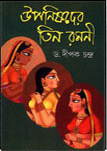 Upanisad is not a mere Philosophy. True story of man’s life
has been entailed in it to render philosophy easier. Nothing human was
there in the thought of Brahma in the life circle of Gargi. Moitrei and Katyani . In the life of human the sweet evolutionof
Katyayani has occurred.
Upanisad is not a mere Philosophy. True story of man’s life
has been entailed in it to render philosophy easier. Nothing human was
there in the thought of Brahma in the life circle of Gargi. Moitrei and Katyani . In the life of human the sweet evolutionof
Katyayani has occurred.
|
|
|
|
Suvadra Ananya
|
|
|
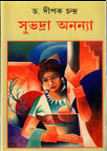 One of the episodes of the life of Pandavas was upto before
the appearance of Suvadra. But her appearance imparted not only a new
colour to the mahabharat narrative but also several turns to it. This
narrative portrays how much helpful and beneficial this Krishna’s sister was in their days of miseries and
sufferings.
One of the episodes of the life of Pandavas was upto before
the appearance of Suvadra. But her appearance imparted not only a new
colour to the mahabharat narrative but also several turns to it. This
narrative portrays how much helpful and beneficial this Krishna’s sister was in their days of miseries and
sufferings.
|
|
|